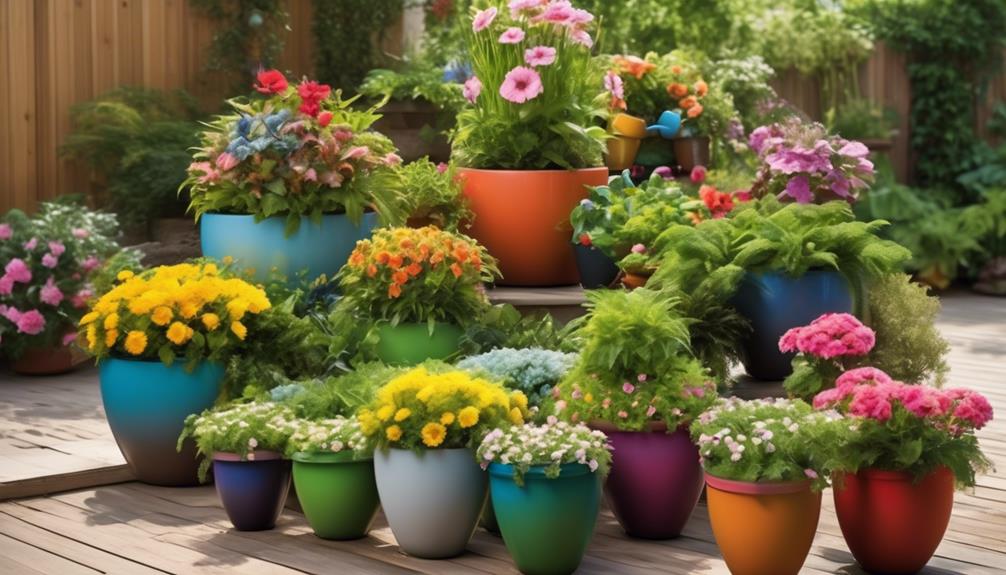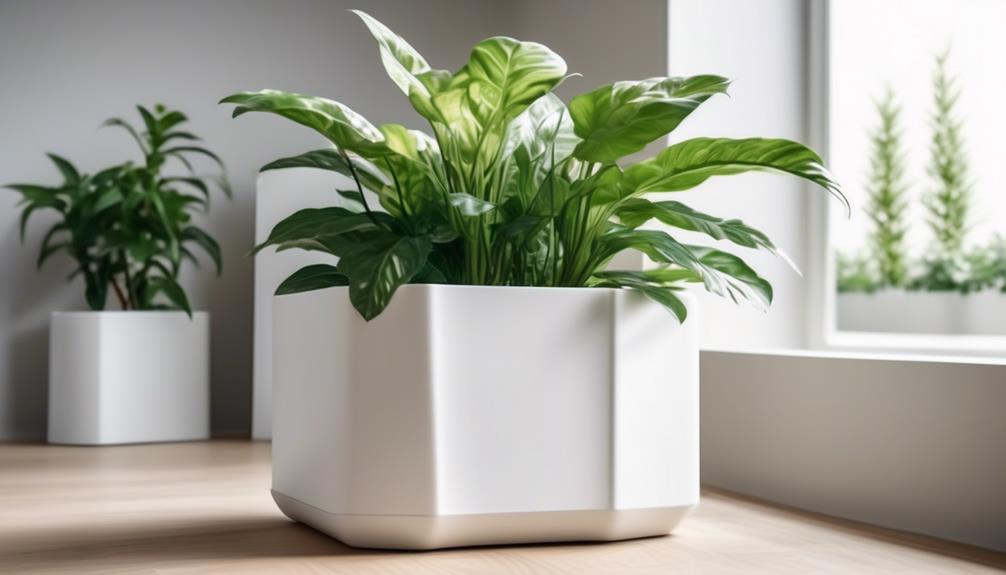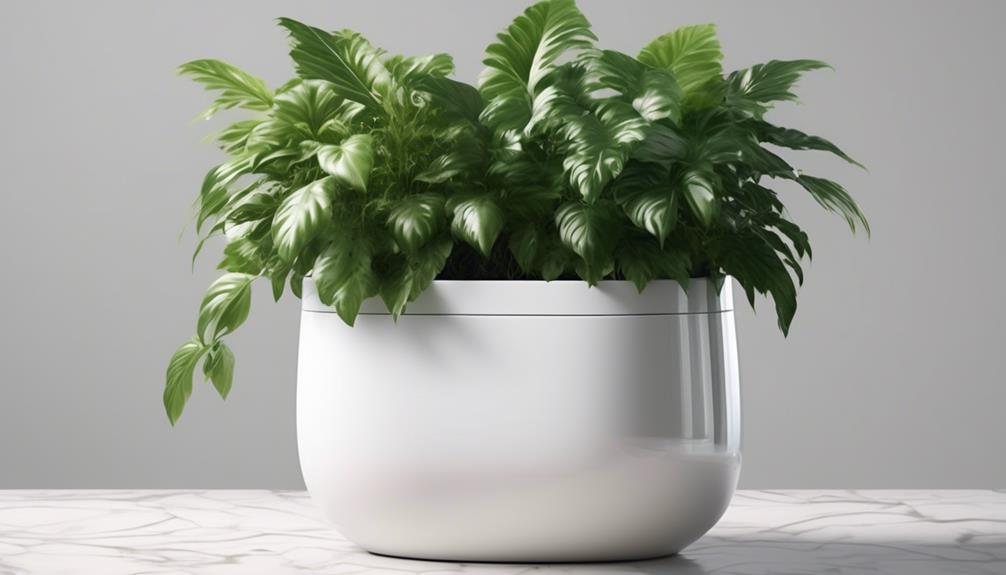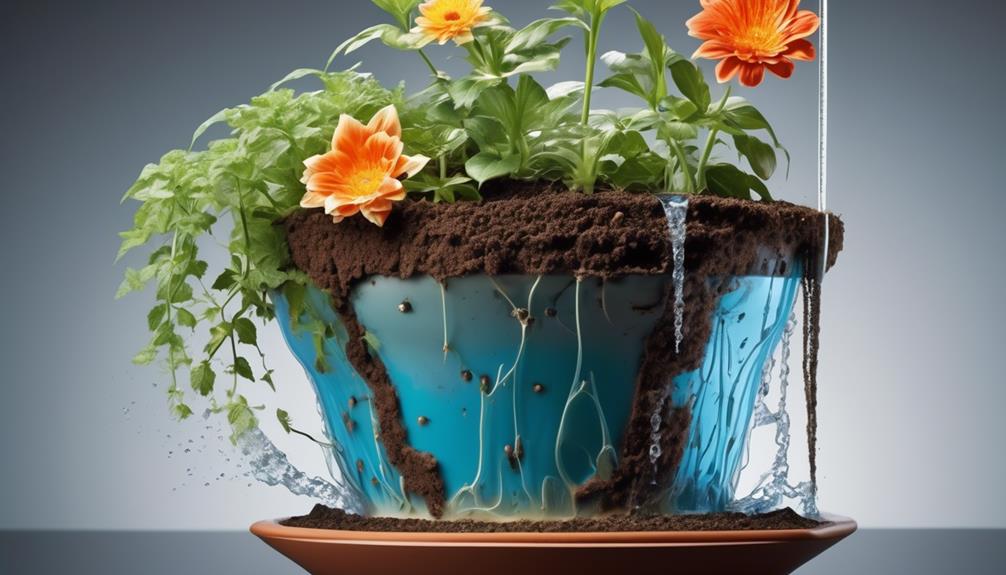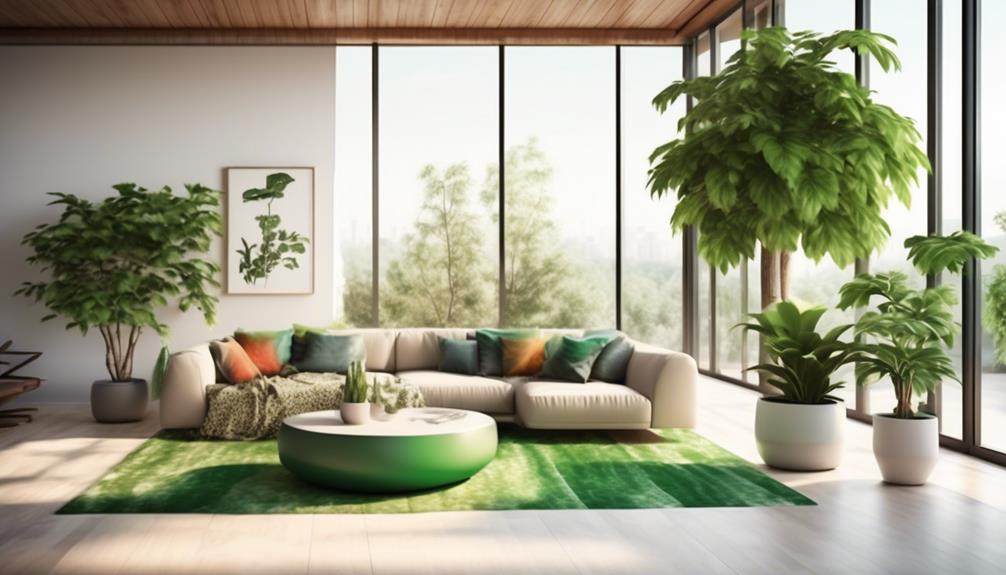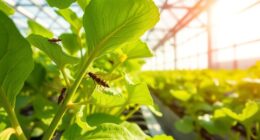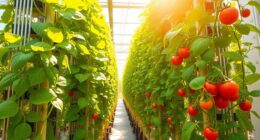In our garden oasis, we are always exploring innovative ways to tend to our plants, and the idea of self-watering containers for outdoor plants has truly piqued our interest.
The concept of these pots is intriguing, but do they live up to the hype? Are they truly a game-changer for busy plant lovers, or just another gimmick?
Join us as we explore the ins and outs of self-watering outdoor plant pots and uncover whether they're worth the investment for a hassle-free gardening experience.
Key Takeaways
- Self-watering outdoor plant pots are a convenient solution for maintaining optimal moisture levels in potted plants.
- They reduce the need for frequent watering and minimize the risk of over or under-watering.
- Self-watering pots ensure a more stable soil moisture level, promoting proper growth and stability.
- When choosing self-watering outdoor plant pots, consider the specific needs of the plant species, environmental conditions, material options, and size considerations.
Advantages of Self-Watering Plant Pots
Self-watering plant pots offer a convenient solution for maintaining optimal moisture levels in potted plants, reducing the need for frequent watering and minimizing the risk of over or under-watering. When using traditional pots, maintaining a consistent watering schedule can be challenging, often leading to fluctuations in soil moisture.
This inconsistency can stress plants, affecting their growth and overall health. However, with self-watering pots, the built-in reservoir provides a steady supply of water to the plant's roots, ensuring a more stable soil moisture level.
This feature is particularly beneficial for individuals who may not have the time to adhere to a strict watering schedule or for those who are new to gardening and may be unfamiliar with the specific needs of different plant species.
Choosing the Right Self-Watering Pot
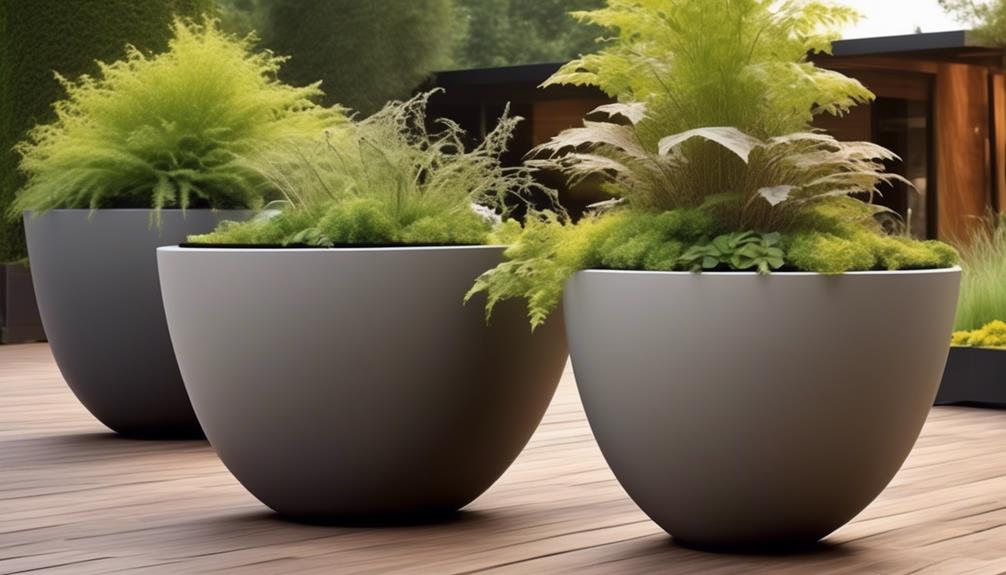
When selecting a self-watering pot for your outdoor plants, it's essential to consider the specific needs of the plant species and the environmental conditions in which they'll be placed.
Material options play a crucial role in choosing the right self-watering pot. For instance, plastic pots are lightweight and retain moisture well, making them suitable for plants that prefer consistently moist soil. On the other hand, terracotta pots are porous and allow for better airflow to the plant's roots, making them ideal for plants that require well-draining soil.
Size considerations are equally important. A pot that's too large can lead to overwatering, while a pot that's too small may not provide sufficient water for the plant's needs. It's vital to select a pot size that accommodates the plant's root system while allowing for adequate soil moisture. Additionally, the pot's size should also be in proportion to the plant's size to ensure proper growth and stability.
Tips for Maintaining Self-Watering Pots
After carefully selecting the right self-watering pot for your outdoor plants based on material and size considerations, it's crucial to understand the essential tips for maintaining these pots to ensure the optimal health and growth of your plants.
When it comes to maintaining self-watering pots, monitoring the watering frequency is crucial. Check the soil moisture regularly, and water the plants only when the soil is dry to the touch. This helps prevent overwatering, which can lead to root rot and other issues.
Additionally, it's important to clean the self-watering system periodically to prevent clogs and ensure proper water distribution. Inspect the watering mechanism for any blockages and clean it as needed.
Moreover, consider using a soil mix that's suitable for self-watering pots, as it can help maintain adequate moisture levels and promote healthy plant growth.
Best Plants for Self-Watering Containers

Selecting the best plants for self-watering containers involves considering the specific water and sunlight needs of the chosen plant species to ensure optimal growth and health.
When it comes to container gardening, it's essential to choose plants that thrive in the confined space and can withstand the self-watering system.
For indoor herbs, consider options like rosemary, thyme, basil, and mint. These herbs require well-drained soil and moderate sunlight, making them ideal for self-watering containers.
Additionally, certain vegetables such as cherry tomatoes, peppers, and lettuce are well-suited for self-watering pots. These plants typically have shallow roots and can adapt well to the consistent moisture provided by the self-watering system.
When selecting plants for self-watering containers, it's crucial to account for their mature size and growth habits. Compact and dwarf varieties are often the best choices, as they can thrive within the limitations of a container.
DIY Self-Watering Pot Options
To create DIY self-watering pots, you can repurpose common household items to build an efficient and cost-effective watering system for your plants. Customizing self-watering systems allows for personalized solutions that cater to the specific needs of your plants.
Here are three sustainable watering solutions you can easily make at home:
- Plastic Bottle Irrigation: Cut the bottom off a plastic bottle, drill a small hole in the cap, and bury the bottle upside down in the soil near the plant. Fill the bottle with water, and it will slowly release moisture to the roots as the soil dries out.
- Capillary Mat System: Place a cotton or felt mat in a tray filled with water. The mat will soak up the water and draw it up into the soil through capillary action, keeping the plants consistently hydrated.
- Upside-Down Watering: Invert a plastic or glass bottle with a small opening and bury it neck-deep in the soil. Fill the bottle with water, and it will gradually seep into the soil, providing a slow and steady water supply.
These simple DIY options offer practical and effective ways to maintain healthy, well-watered plants while reducing water waste.
Frequently Asked Questions
Are Self-Watering Outdoor Plant Pots Suitable for All Types of Outdoor Plants, Including Succulents and Cacti?
Yes, self-watering outdoor plant pots are suitable for a variety of outdoor plants, including succulents and cacti. Succulents require well-draining soil and infrequent watering, and self-watering pots can help maintain the right moisture balance.
These pots can be a convenient option for container gardening, allowing for better plant maintenance and reducing the risk of overwatering. They provide a practical solution for succulent care, ensuring proper watering techniques and supporting healthy plant growth.
Can Self-Watering Pots Be Used in Extreme Weather Conditions, Such as High Heat or Freezing Temperatures?
In extreme weather conditions, self-watering pots can have a significant impact on plant growth. They can help maintain consistent moisture levels, which is crucial for plant health during high heat or freezing temperatures.
The self-watering feature reduces the risk of under or overwatering, providing a stable environment for plants to thrive.
It simplifies maintenance by minimizing the need for frequent watering, making it convenient and beneficial for plants in challenging weather conditions.
How Often Do You Need to Refill the Water Reservoir in a Self-Watering Outdoor Plant Pot?
We find that the watering frequency of a self-watering outdoor plant pot depends on various factors, including the plant type and environmental conditions.
Regular maintenance involves checking the water reservoir and refilling it as needed. For example, in hot and dry climates, the reservoir may require more frequent refilling to support the plants' water needs.
It's essential to choose plant types compatible with self-watering pots to ensure optimal performance.
Can Self-Watering Pots Be Used for Hanging Plants or Vertical Gardens?
Yes, hanging planters are a great option for self-watering pots, making it easier to maintain the moisture levels.
When it comes to vertical gardens, self-watering pots can be a convenient choice, as they help regulate water usage efficiently. This is beneficial for the plants and reduces the need for frequent watering.
Such pots are designed to distribute water gradually, ensuring that plants receive consistent moisture, which is essential for vertical gardens.
Are There Any Special Considerations for Using Self-Watering Outdoor Plant Pots in Areas With Heavy Rainfall or High Humidity?
In areas with heavy rainfall, self-watering outdoor plant pots offer great benefits. However, special considerations are needed.
We've found that adjusting the watering system to account for the additional moisture is essential. This prevents overwatering and potential root rot.
Also, selecting pots with good drainage can help manage excess water. We've had success using these methods, keeping our plants healthy even in high rainfall and humidity.
Are White Self Watering Plant Pots as Effective as Other Outdoor Plant Pots?
Yes, white self watering plant pots are just as effective as other outdoor plant pots. The self watering feature ensures that the plants receive the right amount of water, making it easier to maintain them. The color of the pot does not impact its functionality, so you can choose any design that fits your outdoor space.
Conclusion
In conclusion, self-watering outdoor plant pots offer a convenient and efficient way to keep your plants hydrated. But before you go out and purchase one, make sure to consider the specific needs of your plants and the type of pot that will work best for them.
With the right choice and proper maintenance, you can enjoy lush and healthy greenery in your outdoor space without the hassle of constant watering.
Stay tuned for more tips on how to make the most of your self-watering pots!

